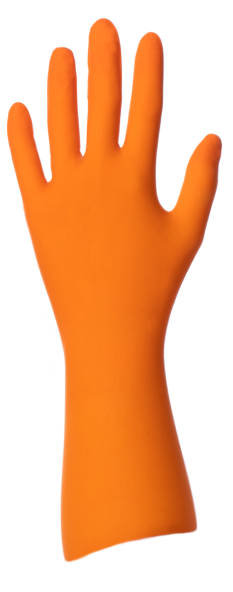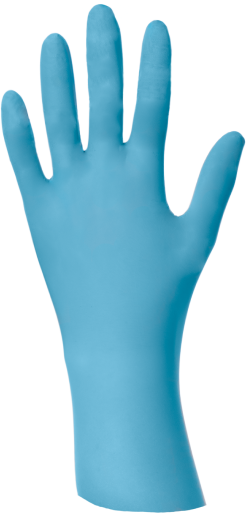WHICH CHEMICAL RESISTANT GLOVES TO PROTECT AGAINST CHEMICAL RISKS?
Handling chemicals, some of them dangerous, is very common in the laboratory, cleanrooms and in many other industries.
It is therefore essential to know which chemical resistant single-use gloves to choose to protect your hands from the chemical splashes' risks.
WHAT IS CHEMICAL RISK?
According to the International Labour Organization (ILO), a chemical refers to chemical elements and their compounds, whether natural or synthetic. The ILO classifies hazardous chemicals according to the type and degree of physical and health hazards. (Source: ILO Chemicals Convention No. 170 – 1990 and Safety and Health at Work Report 2014).
Chemical risk is defined as the possible result of exposure and/or use of a hazardous chemical agent considering its potential to cause harm to the human body or even death.
Frequently identified physical risks and impacts on health are related to splashing, fires, explosions and inhalation of chemicals as well as ecotoxicity (impacts on ecosystems). The effects depend on the nature of the chemicals (toxicity characteristics), the exposure pattern (how the chemicals enter the body; level, frequency duration of exposure, etc.) and the initial state of health before exposure.
The most commonly health effects observed are irritation, itching, burning, eczema, asthma, cancer, fertility concerns .... These effects can occur a long time (several months or even years) after exposure. LIt is therefore essential that workers handling or being exposed to potentially toxic chemicals in the laboratory and cleanroom are protected wearing appropriate Personal Protective Equipment (PPE), including chemical resistant disposable gloves.
It is therefore essential that workers handling or being exposed to potentially toxic chemicals in the laboratory and cleanroom are protected wearing appropriate Personal Protective Equipment (PPE), including chemical resistant disposable gloves
WHO IS CONCERNED BY EXPOSURE TO CHEMICAL RISKS?
Chemicals, potentially harmful, are used in daily life by millions of people worldwide: it can be cleaning, hygiene, DIY products or in products intended for clothing, food, cosmetics etc. ...
In the workplace, the ILO estimates that “more than one billion workers worldwide are exposed to hazardous substances” every year.(https://www.ilo.org). It is therefore a major issue of protection in the workplace.
Chemicals are used in many activities in the workplace such as production, handling, storage, cleaning, maintenance and servicing, transport, disposal or treatment of waste... Unfortunately, releases to the environment can also occur.
People working in the chemical industry are obviously the most strongly and directly affected by exposure to hazardous chemicals.
But chemical risks are also very common in other industries:
Painting (automotive production...)
Construction (welding, gluing...)
Medical (when reconstituting drug solutions or preparing cytotoxic drugs)
Laboratory (research, production, analysis...)
Pharmaceutical manufacturing
Agriculture
Transport
Etc ...
Employers must therefore ensure that the risk of exposure to chemicals is anticipated through organizational, collective or individual protection measures.
Wearing chemical resistant gloves appropriate to the type of chemical being handled serves an essential role in the protection of workers.
HOW TO PREVENT FROM CHEMICAL HAZARDS EXPOSING?
National Occupational Health (OSH) services, in many countries, require every company to manage the chemical risks related to their activities and to ensure the health & safety of its employees while handling hazardous chemicals.
The starting point is often to conduct a risk assessment before implementing risks management measures:
The company will first identify the chemicals used, then assess how these chemicals are used in the different workplaces. The company must also identify the hazards to human health and to the environment in order to determine the level of risk. All chemicals should be correctly marked to be easily and quickly identified by users.
The company will then implement appropriate protective measures with monitoring and reporting to ensure they remain appropriate to the activities.
These may be organizational measures (work organisation changes, removal, limitation or replacement of hazardous chemicals, etc.) or technical measures (products storage, ventilation systems, Personal Protective Equipment (PPE), etc.).
Finally, the company must inform, give appropriate instructions to its employees and track their health.
Regular employees’ trainings regarding these chemicals and the risks associated should be run to know how to don and wear the Personal Protective equipment (PPE) such as compliant and appropriate nitrile or latex laboratory or clean room gloves.
WHICH GLOVES TO SELECT TO PROTECT AGAINST CHEMICAL RISKS?
Protective gloves against chemical risks must first be registered as category III protective gloves (Complex design as defined as irreversible or fatal risks) in accordance with Regulation (EU) 2016/425.
Single-use protective gloves presumed chemically resistant in accordance with ISO 374-1:2016+A1:2018 display the Erlenmeyer symbol stating the 3 tests below have been completed:
(according to the ISO 374-4:2019): This test evaluates the resistance of the protective glove materials to degradation by a chemical. It measures the change in gloves puncture resistance (and therefore their physical properties) after continuous contact of their external surface with the chemical to be tested. Read our article to learn more about the gloves resistance to degradation.
Single-use gloves used against chemical hazards are classified into 3 types according to their level of performance against a number of chemicals listed in ISO 374-1:2016+A1:2018:
- Type A gloves
Gloves tested for at least 6 from the 18 chemicals on the list with a minimum breakthrough time of 30 minutes (Level 2).
- Type B gloves
Gloves tested for at least 3 from the 18 chemicals on the list with a minimum breakthrough time of 30 minutes (Level 2).
- Type C gloves
Gloves tested for at least 1 from the 18 chemicals on the list with a minimum breakthrough time of 10 minutes (Level 1).
However, at SHIELD Scientific, we believe that information on Type (A, B, or C) or performance level (0-6) does not provide precise enough insights allowing to choose the most suitable nitrile or Latex lab or cleanroom glove to protect you from hazardous chemicals.
Thus, we do provide for all nitrile gloves and SHIELD Scientific latex gloves, with a documentation indicating the exact breakthrough time for each of the chemicals tested.
In addition to this, always keep in mind that the thickness will have a significant impact on the chemical’s breakthrough time: the thicker the gloves, the better they protect, even if the gloves are type A!
Find all our gloves’ chemical data* in our online chemical resistance guide of gloves where you can search and sort the information by chemical name, CAS number and/or SHIELD Scientific Nitrile glove or latex glove.
You can also select the best glove for chemical hazard protection using our SHIELD Scientific Glove Selection Guide.
Do not hesitate to contact us for more information.
* If you cannot find the chemical test data that you are seeking, please do not hesitate to contact us. Disclaimer: The data provided was based on gloves tested under laboratory conditions, in accordance with EN 16523-1:2015 (formerly EN 374-3:2003) and EN 374-4:2013. The information is for guidance only and may not reflect the user's application. A risk assessment should always be made by purchaser to assess the suitability of gloves for a specific application.






